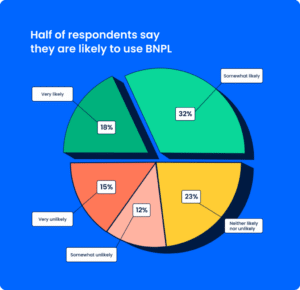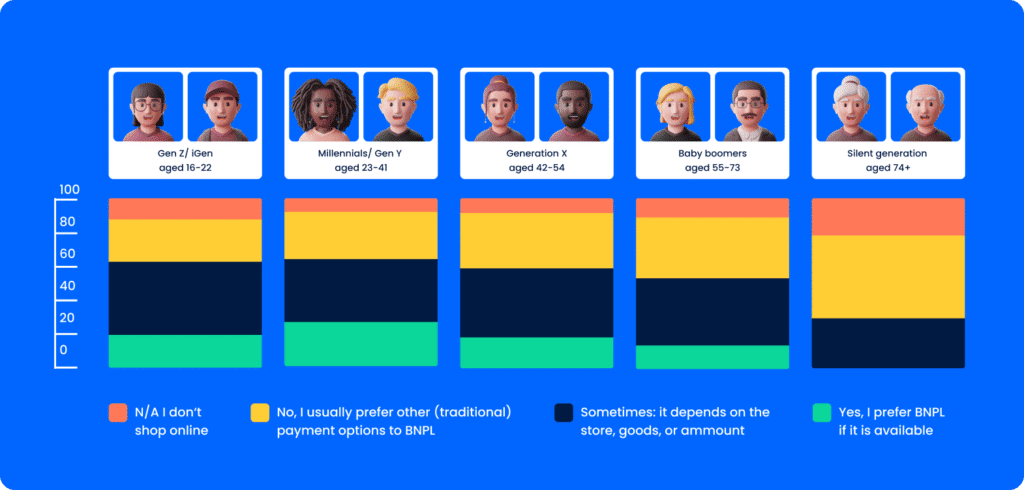
By Kyla Reed - April 17, 2024
Vibrant Credit Union: Breaking Industry Barriers with Embedded Lending
Growing competition is forcing banks and credit unions to rethink their revenue strategies. Read how one credit union used embedded
With buy now, pay later (BNPL) becoming ubiquitous in digital retail, and the numbers of users rising steadily, it’s likely you’ve heard of Klarna, Afterpay, Affirm, and other BNPL providers.
You may have even considered using (or have already used) BNPL at some point. But knowing about BNPL – and using it once or twice – won’t answer some of the financial industry’s biggest questions about its longevity, its customer base, and its future.

Current accepted knowledge tells us that the BNPL phenomenon is being driven by a younger cohort of consumers: Gen Z. But push the stereotype of fast fashion twenty-somethings who can’t afford to “pay now” but want instant gratification from your mind. As with any generation, Gen Z is a diverse collection of goals and aspirations, encompassing a massive landscape of financial proclivities.
At FintechOS we believe Gen Z is critical to understanding the future of financial services. We also believe that we are dealing with something much bigger with BNPL disruption.
If there’s one thing everyone has to accept about digital financial services, it’s that you can’t get away with one size fits all anymore. So, to inform the FintechOS product and better understand the solutions our customers are building with our platform, we set to find out more about the end consumers who use BNPL – and we busted some commonly accepted myths in the process.
Our survey, in partnership with Censuswide, spoke to consumers of all ages in France, Germany, and Spain and here are some of our initial findings.

Our survey numbers clearly disagree, showing that it is for everyone. While it’s true that the data shows it is weighted to the young generations, even the boomers are not all negative.
Yes, Gen Z and millennials are 1.5x more likely to use BNPL than boomers. And yes, there are twice as many people who are very unlikely to use BNPL among boomers compared to younger generations. However, over a third of boomers would still consider using BNPL.
So while the drop-off is certainly there, the ongoing mainstreaming of BNPL is clearly reaching every age group, even to the point that a growing percentage of shoppers would take BNPL not just as a payment option possibility but as their first choice:
Our survey shows strong demand in these three markets:
While consumers in Germany (18%) are the most likely to take BNPL as their first payment option over traditional alternatives, overall, Spain has the highest net likelihood (57%) of choosing BNPL to pay for goods and services.
In fact, the highest rates of preference for BNPL came from the two highest household income brackets of our respondents. In addition, according to our survey, 58% of high-income shoppers favor BNPL, often choosing it as their first payment method option.
Actually, in our survey, fashion was in 4th place, with consumer electronics coming out as the top category for BNPL purchases.
Different generations express different preferences. The bottom line? Wherever people are shopping, there’s a growing proportion of them who would like a BNPL option for it.
Shoppers would consider BNPL as a way to pay local businesses and tradespeople, if the option were available. In fact, close to three-quarters of all our respondents would consider using BNPL for at least one category of small business purchase, including such things as hotels (31% of respondents), local shops, restaurants, and trade services.
While a majority of these businesses may not be currently online, there is definite uptake potential. Paying for a kitchen on some kind of installment plan isn’t new, but wouldn’t it be great to have the option of doing the same to fix a plumbing or car emergency, and getting it all done in a seamless and simplified way?
BNPL is set to alter consumer behavior in a radical way. We can already see its disruption of the credit card and payment industries, as well as its effects on e-commerce – for online behemoths and small independents, and most businesses in between. And we predict that the emergence of new technologies will make it even more seamless in application.
As BNPL matures and goes further mainstream, we can help ensure you don’t risk getting left behind by this new paradigm. We are constantly fine-tuning our platform, and expanding our capabilities in exciting new ways. In fact, we’ve developed updates that now allow us to empower a bank to offer SME customers a BNPL option in a consumer-facing payment gateway, so that they can add BNPL to their usual payment methods, improving conversion and convenience.
Read more about how we can help create your own customer-centric BNPL solutions.
***
***
Survey methodology
***